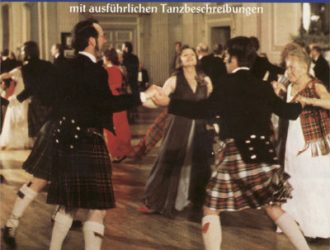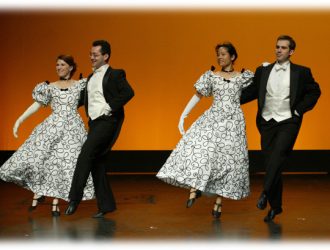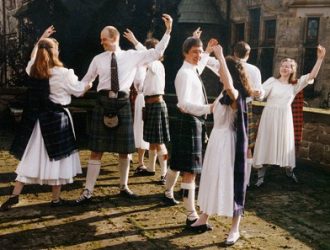Schottische
The Schottische is a partnered country dance, that apparently originated in Bohemia. It was popular in Victorian era ballrooms as a part of the Bohemian folk-dance craze and left its traces in folk music of countries such as Argentina, Finland, France, Italy, Norway, Portugal, Brazil, Spain, Sweden, Denmark, and the United States, among other nations.
Overview#
One of the most popular couple dances of the mid-to late 19th century, the Schottische first began appearing in dance manuals in the 1850s. The noted Parisian dance teacher Henri Cellarius, writing in the late 1840s, did not mention it at all.
Origin#
In Markowski et ses salons, a gossipy look at the Parisian demi-monde published in 1860, it is claimed that Polish dancer and Parisian dancing master Markowski invented “la scottish” (among many other dances, including the Hongroise) during a period of dire poverty but great choreographic creativity in the 1850s. The picture of the great dancer creating dances in his lonely Parisian garret has charm but in the case of the schottische, seems unlikely to be accurate.
Markowski may have publicized the dance in Paris, but in 1885, German dancing master Friedrich Zorn stated (in German in the original; excerpts here are from the English translation published in 1905) that:
“In the year 1850 there appeared, in all parts of Europe, the “Schottische,” a round dance which had, as early as 1844, been executed in Bavaria under the name “Rheinlander,” and in the Rhenish countries it was known as the “Bavarian Polka.”
American dance master Allen Dodworth claimed (in his 1885 manual) to have introduced it to his pupils in 1849, and another American dance master, Edward Ferraro, explained in 1859 that:
“The Schottisch was introduced a short time after the Polka, and acquired great favor in America. It is still held in high repute by the Germans, from whom it is, by some, supposed to have emanated.”
London dance teacher Mrs. Nicholas Henderson, in her mid-1850s dance manual, was more definite:
“It is in fact, a German peasant dance. The music, too, is German, although many suppose it to be of recent composition.”
The name of the newly popular dance went through various spellings in its early years. Friedrich Zorn agrees with the Markowski book on its early spelling:
“This dance was known in France, England, Russia, Italy, Greece and various other countries as the “Scottish,” and it would be difficult to explain, if indeed, it could be satisfactorily determined, how the title “Schottische,” which is the German form of the word, ever came to be so definitely applied to the dance as to warrant its adoption, untranslated, into the languages of all the countries referred to.”
Mrs. Henderson referred to it in different publications as the “Schottisch” and the “Schottische”, while the Parisian dance master Gawlikowski, as his Guide Complet de la Danse went through different editions, corrected his 1858 “Schotisch” to 1862’s “Schottisch.” The spelling with the final “e” became the standard.
Despite the dance’s popularity, at least one author, of the anonymous American manual Beadle’s dime ball-room companion and guide to dancing (1868) was contemptuous toward the schottische:
“This is probably danced less than any of the other round dances in “best circles,” being deemed “vulgar.” With children and young persons it is, however, still a favorite; and therefore we give a description of the manner in which it is danced.”
Technique#
Mrs. Henderson’s attitude, copied word-for-word by Durang (c1856) and Hillgrove (1857), is more common:
“The Schottisch is now becoming quite universal. It does not require so much practice as many of the other dances, and when properly danced, it is a very elegant and withal a particularly pleasing movement, for it is a combination of two movements, a polka movement and a circular hop movement; and the two combined make up a most agreeable variety not to be found either in the Polka, the Deux Temps or Redowa.”
She goes on to helpfully warn gentlemen of their responsibilities in the schottische and the dire consequences of error:
“The step is very easy, but the double movement requires so much more care and attention than the Polka, that it becomes difficult for the Gentleman to guide his partner through the mazes of the Schottisch without encountering many of those awkward mishaps, such as treading upon toes and dresses, to which unskillful dancers are constantly subject.
It is chiefly in the circular, or hop movement, that the difficulty is experienced, for if the time be not precisely kept, so as to make the two hops perfectly simultaneous, a collision is inevitable, and a solemn pause immediately follows, to the great disappointment of both parties, but especially of the Gentleman, on whom the chief responsibility lies.”
Music#
The schottische is described, variously, as being in either 4/4 time or slow 2/4 time.
Dozens, or even hundreds, of pieces of music for the schottische survive in libraries and sheet music collections today.
Performance of the Schottische#
The schottische is divided into two parts; Zorn refers to them as the balancée (or rocking) and the sauteuse (or hopping). The few sources which specify dance position agree that the dance is performed in Waltz (closed hold) position, as in the Polka; the side by side position of the later “military” schottische is nowhere to be found in the early sources for the dance.
The first part of the schottische consists of a sequence generally described as:
1. Slide the leading foot (gentleman’s left, lady’s right) sideways 2. Close the second foot (some sources specify behind, or behind in third position) 3. Slide again or leap with the first foot 4. Hop on that foot.
The entire sequence then repeats leading with the second foot.
Most sources describe both the first and third movements as a glide or slide; this description is found in Zorn, Henderson, Howe (1862), Hillgrove (1857 & 1863), Brooks, deGarmo Brookes, Durang, Ferrero, and Beadle’s. Coulon, Roberts, and an earlier edition of Howe (1858) describe three “walking” steps. Gawlikowski is alone in this set of sources in describing the third step as a “leap”; he also compares it to an elongated polka (at its most technical, a slide-cut-leap sequence) followed by a hop.
In the second part of the schottische, the sauteuse is usually described as a series of “leaps” followed by “hops” or occasionally as double “springs”, similar to the Jeté or Quick Sauteuse Waltz of the Regency era (though probably without the extended foot on the hops!)
1. Leap 2. Hop 3. Leap 4. Hop
(those four counts then repeated for a total of four “leap-hops”)
This is consistent across the majority of sources used: Henderson, Gawlikowski, Zorn, Howe, Coulon, DeGarmo, Durang, Ferrero, Beadle’s, and the 1857 edition of Hillgrove. Zorn (published in 1885 but reflecting the practices of the elderly author’s younger days) adds the further information that the free foot is raised in third position behind the other while hopping. However, the 1863 edition of Hillgrove and Brooks (1866) describe the move as a “step” rather than a leap or spring. DeGarmo Brookes (1867) gives either a leap or step. Leaping seems to be the preferred method, though modern performance generally involves the more sedate “step”.




